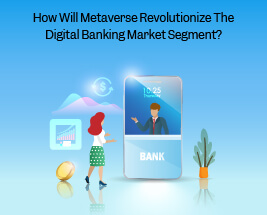it’s undeniable that the COVID-19 outbreak has led to a widespread digitalization of various industrial dimensions. Because of the lockdown, there has been a huge increase in online shopping and other eCommerce transactions. The digital banking market venture has gained tremendous traction. As cash utilisation has been declining rapidly, the development of advanced payment solutions has led to the rapid digitalization of the entire banking process.

Such technological advancements have enabled digital banks to be equipped with real-time assistance, custom offerings, and shorter turnaround times. It has also ensured an improved user experience, which in turn is leveraging digital banking adoption across the globe. Eventually, cryptocurrencies have been unprecedented lately, especially around COVID-19 lockdowns. It has now become a trillion-dollar market, with enormous tokens already in existence while new ones rapidly emerge every day.
Apart from this, uncertainty revolves around these growing assets, which means that their outlook among the financial corporations was not forthcoming. But because institutions and the general public are quickly adopting digital currencies, banks and other financial institutions are now trying to work them into their business plans.
Nowadays, a wide range of payment gateway solutions providers are introducing multiple integrated payment methods for seamless processing of your payments, i.e., WP Formify is an integrated payment processing plugin for WordPress platforms. Several similar technologies, such as decentralised applications (dApps), NFTs, and the Metaverse, have been gaining traction lately. However, each of these has the potential to revolutionise the financial sector. The most promising is the concept of the Metaverse, from which the virtual world expects to transform the entire banking operations for both customers and financial institutions.
Why Metaverse is the Future of Digital Banking?
To simplify, Metaverse is the combination of different technologies that include AR, VR, Machine Learning, Artificial Intelligence, and Blockchain. Combined technologies can allow people to interact effectively in a 3D virtual space environment.
Currently, Metaverse is predominately linked with the gaming sector. Devices like PSVR 2, Oculus Rift, and games such as Decentraland are already gaining significant popularity. It is worth noting here that the gaming industry is currently worth USD 300 billion based on Accenture and will continue to depict similar growth trends to recent years and vice versa.

It makes the banking sector the next frontier in the Metaverse. With the passage of time, customers can visit banks via a virtual reality device without stepping out of their homes. Eventually, major financial corporations tend to make heavy investments given the potential of banking in the Metaverse, which positively influences the digital banking market dynamics. If you want to see this opportunity, various banks are exploring their potential in the blockchain industry and the Metaverse. These are financial technology startups that are already specialising in this field. For example, the top FinTech companies now offer debit cards that use augmented reality and can be seen on a smartphone.
What Impact Will Metaverse Have on the Banking Dimensions?
It is claimed that the Metaverse has the potential to optimise banking exposure for people in multiple ways. But some of these will have effects that have never been seen before, and others will change how customers see things from behind the scenes.
Improved User Experience in a 3D Environment
Metaverse will have an online virtual space where customers can transact, avail themselves, and access banking information from the comfort of their homes. It is expected to make things easier, like applying for a loan or opening a new bank account.The ability to manage multiple transactions and finances will emerge as a primary highlight for ensuring an immersive and improved user experience in the Metaverse, which will transform how the digital banking industry will expand in the upcoming decade. Similarly, the Metaverse will enable banks to reinforce connections with existing customers in a meaningful way.
The Prospects of New Products
The products aligned with metaverse technology, including cryptocurrencies, NFTs, and virtual goods, have received worldwide recognition. The deployment of virtual real estate and NFTs will be an essential factor in the growth of the Metaverse. Hence, banks will be required to accept cryptocurrency for customers to buy and sell these products.
NFTs are already being displayed in a prevailing metaverse. Decentraland via banks could potentially provide loans and accept tokens as collateral in the virtual environment. The banking institutions can also be integrated with NFT payment support by establishing a dedicated exchange point within the Metaverse, which in turn complements digital banking market dynamics.
However, virtual real estate is another asset banks can look forward to. Virtual land spaces in meta games such as sandbox and Decentraland are being sold for millions. For instance, Africa’s first metaverse, called Africarare, managed to sell 149 virtual plots in the first eight minutes of starting the online sales.
Fintechs Plays A Vital Role In Metaverse Banking Aspects
Fintech innovations have long been pushed to streamline financial services via online mediums. As most financial technology companies are based on digital elements, they are expected to play a vital role in metaverse banking that further establishes themselves as the future of finance.
It remains to be seen how many revolutions will happen in the financial services sector. However, legacy banking is still classified in the early stages of digitalizing machine learning and artificial intelligence patterns. The precise question will be how much of an impact banking and transactions in the Metaverse have on the entire banking structure. It would be interesting to see how these changes affect the growth of digital banking.
Heading towards Metaverse
The payments landscape is always set to evolve, and financial institutions and digital banks must be completely equipped to stand up to the changes and play an integral part in the Metaverse community. Organizations preparing to disrupt emerging technologies such as AI and rapidly responding to situations such as a pandemic will be required to strategically pivot to undertake the next level of accelerating the Metaverse’s progress over the next decade.



